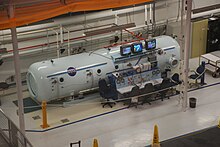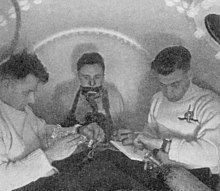List of signs and symptoms of diving disorders
The principal conditions are
The disorders are caused by breathing gas at the high pressures encountered at depth, and divers will often breathe a gas mixture different from air to mitigate these effects. Nitrox, which contains more oxygen and less nitrogen, is commonly used as a breathing gas to reduce the risk of decompression sickness at recreational depths (up to about 40 metres (130 ft)). Helium may be added to reduce the amount of nitrogen and oxygen in the gas mixture when diving deeper, to reduce the effects of narcosis and to avoid the risk of oxygen toxicity. This is complicated at depths beyond about 150 metres (500 ft), because a helium–oxygen mixture (heliox) then causes high pressure nervous syndrome.[1] More exotic mixtures such as hydreliox, a hydrogen–helium–oxygen mixture, are used at extreme depths to counteract this.[2]
Decompression sickness

| DCS type | Bubble location | Clinical manifestations |
|---|---|---|
| Musculoskeletal | Mostly large joints |
|
| Cutaneous | Skin |
|
| Neurologic | Brain |
|
| Neurologic | Spinal cord |
|
| Constitutional | Whole body | |
| Audiovestibular | Inner ear |
|
| Pulmonary | Lungs |
|
Arterial gas embolism and pulmonary barotrauma

If the compressed air in a diver's
| Symptom | Percentage |
|---|---|
Loss of consciousness
|
81 |
| Pulmonary rales or wheezes
|
38 |
| Blood in the ear (Hemotympanum) | 34 |
| Decreased reflexes
|
34 |
| Extremity weakness or paralysis | 32 |
| Chest pain | 29 |
| Irregular breathing or apnea | 29 |
| Vomiting | 29 |
| Coma without convulsions | 26 |
| Coughing blood (Hemoptysis) | 23 |
| Sensory loss | 21 |
| Stupor and confusion | 18 |
Vision changes
|
20 |
| Cardiac arrest | 16 |
| Headache | 16 |
| Unilateral motor changes | 16 |
| Change in gait or ataxia | 14 |
| Conjunctivitis | 14 |
| Sluggishly reactive pupils
|
14 |
| Vertigo | 12 |
convulsions
|
11 |
Other conditions that can be caused by pulmonary barotrauma include
This section needs expansion with: symptoms of pneumothorax, mediasinal emphysema and interstitial emphysema. You can help by adding to it. (March 2020) |
Nitrogen narcosis

| Pressure (bar) | Depth (m) | Depth (ft) | Manifestations |
|---|---|---|---|
| 1–2 | 0–10 | 0–33 |
|
| 2–4 | 10–30 | 33–100 |
|
| 4–6 | 30–50 | 100–165 |
|
| 6–8 | 50–70 | 165–230 | |
| 8–10 | 70–90 | 230–300 |
|
| 10+ | 90+ | 300+ |
|
High pressure nervous syndrome

| Symptom | Notes |
|---|---|
| Impairment | Both intellectual and manual dexterity is observed at 180 metres (600 ft), rising to 40% at depths of 240 metres (800 ft)
|
| Dizziness | convulsions .
|
| Tremors | Tremors of the hands, arms and torso are observed from 130 metres (400 ft) onward. The tremors occur with a frequency in the range of 5–8 hertz (Hz), and their severity is related to the speed of compression; the tremors reduce and may disappear when the pressure has stabilised. |
| EEG changes | At depths exceeding 300 metres (1,000 ft), changes in the alpha waves (8–13 Hz).
|
| Somnolence | At depths beyond the onset of EEG changes, test subjects intermittently sleep stages 1 and 2 observed in the EEG. Even when decompressed to shallower depths, the effect continues for 10–12 hours.
|
Oxygen toxicity

Although
During 1942 and 1943, Professor Kenneth W Donald, working at the Admiralty Experimental Diving Unit, carried out over 2,000 experiments on divers to examine the effects of oxygen toxicity. To date, no comparable series of studies has been performed. In one seminal experiment, Donald exposed 36 healthy divers to 3.7 bars (370 kPa; 54 psi) of oxygen in a chamber, equivalent to breathing pure oxygen at a depth of 27 metres (90 ft), and recorded the time of onset of various signs and symptoms. Five of the subjects convulsed, and the others recovered when returned to normal pressure following the appearance of acute symptoms. The table below summarises the results for the relative frequency of the symptoms, and the earliest and latest time of onset, as observed by Donald. The wide variety of symptoms and large variability of onset between individuals typical of oxygen toxicity are clearly illustrated.[12]
| Signs and symptoms | Frequency | Earliest onset (minutes) | Latest onset (minutes) |
|---|---|---|---|
| Lip-twitching | 25 | 6 | 67 |
| Vertigo | 5 | 9 | 62 |
| Convulsion | 5 | 20 | 33 |
| Nausea | 4 | 6 | 62 |
| Spasmodic respiration | 3 | 16 | 17 |
| Dazed | 2 | 9 | 51 |
| Syncope | 2 | 15 | 16 |
Epigastric aura
|
2 | 18 | 23 |
| Arm twitch | 2 | 21 | 62 |
| Dazzle | 2 | 51 | 96 |
| Diaphragmatic spasm | 1 | 7 | 7 |
Tingling
|
1 | 9 | 9 |
| Confusion | 1 | 15 | 15 |
| Inspiratory predominance[note 1] | 1 | 16 | 16 |
| Amnesia | 1 | 21 | 21 |
Drowsiness
|
1 | 26 | 26 |
| Fell asleep | 1 | 51 | 51 |
| Euphoria | 1 | 62 | 62 |
| Vomiting | 1 | 96 | 96 |
- Note
- ^ Normally, breathing in takes less time than breathing out; inspiratory predominance is a reversal of this.
References
Further reading
- "Descriptive Classification of Diving Disorders" (PDF). European Committee for Hyperbaric Medicine. September 2003. Retrieved 22 November 2010.
- Donald, Kenneth W (1947). "Oxygen poisoning in man — part II". British Medical Journal. 1 (4507): 712–7. PMID 20248096.
- Francis, T; James, R; Smith, DJ, eds. (1991). "Describing Decompression Illness". 42nd Undersea and Hyperbaric Medical Society Workshop. UHMS Publication Number 79(DECO)5-15-91. Undersea and Hyperbaric Medical Society.
- Bevan, John (1999). "Early diving problems and fatalities". South Pacific Underwater Medicine Society Journal. 29 (3). Archived from the original on April 15, 2013. Retrieved 2011-06-13.
{{cite journal}}: CS1 maint: unfit URL (link)
